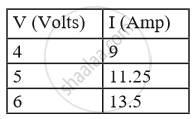Advertisements
Advertisements
Question
How much energy is transferred by a 12 V Power supply to each coulomb of charge which it moves around a circuit?
Solution
The term 'each coulomb' means 'every 1 coulomb'.
So, charge, Q = 1 C
Potential difference, V = 12 V
Now:
V = W/Q
12 = W/1
So, work done, W = 12 x 1 = 12 J
Since the work done on each coulomb of charge is 12 J, the energy transferred to each coulomb of charge is also 12 J.
APPEARS IN
RELATED QUESTIONS
Calculate the work done in moving a charge of 4 coulombs from a point at 220 volts to another point at 230 volts.
A resistance of 20 ohms has a current of 2 amperes flowing in it. What potential difference is there between its ends?
Write down the formula which states the relation between potential difference, current, and resistance.
If the potential difference between the end of a wire of fixed resistance is doubled, by how much does the electric power increase?
The V-I graph for a series combination and for a parallel combination of two resistors is shown in Fig – 8.38. Which of the two, A or B, represents the parallel combination? Give a reason for your answer.
The following table shows current in Amperes and potential difference in Volts.
What will be the nature of the graph between the current and potential difference? (Do not draw a graph.)

Write an expression for the electrical power spent in flow of current through a conductor in terms of resistance and potential difference.
Suppose there are three resistors A, B, and C having resistances r1, r2, and r3 respectively. If R represents their equivalent resistance, establish the following relation `1/"R" = 1/"r"_1 + 1/"r"_2 + 1/"r"_3`, when joined in parallel.
100 J of heat is produced each second in a 4 Ω resistor. The potential difference across the resistor will be:
